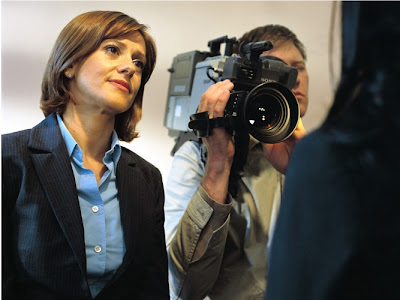From Ian Houston
Mister Darren Sylvester‘s exhibition of photographic prints, painting and sculpture at Sullivan & Strumpf [until Saturday] is a beguiling and seductive collection of art poised, like a plastic surgeon’s scalpel, over the skin of contemporary life.
This is a remarkable show of sophistry by an artist working so deeply in the realm of double blinded irony and signifier play that the possibility of meaning has become vertiginous. Yet this is no simple retreat from a task many of his peers shun as too difficult. The disavowal of meaning, particularly in contemporary photographic work is a familiar trope, often consisting of nothing but a refusal to commit to anything more than the surface of the print. We are all familiar with this type of work. Vistas of banality that resort to arguments of reflection to justify their contempt for depth.

Darren Sylvester, I Care For You, 2007.
Acrylic paint based on Clinique colour surge eye shadow super shimmer, superfit makeup foundation and colour surge butter shine lipsticks, acrylic,
240 x 480 cm (12 panels).
Courtesy Sullivan & Strumpf.
Mister Sylvester’s work is significantly more ambitious than this. His fascination with surface and banality is clear. But this is simply the first move in a long chain of strategic decisions. Witness the collection of painting and sculpture that sits alongside the photography, almost, as a kind of codex. I Care for You a painting of the array of colours available in the Clinique make up range conflates Modernist ideals of the grid with the trash poetry of the beauty industry’s nomenclature. Similarly two “mask” sculptures named after beauty care regimes bring notions of primitivism, even hints of Les Mademoiselles D’Avignon “face” to face with the tragically empty language of the world of “beauty”.
These modernist echoes are subsumed within the suggestive and uncanny mirroring of contemporary life depicted in the photographic prints. Staged vignettes that speak of the mysteries of urban life almost as if they were frames from a narrative, untold but inferred. Teenage girls argue in a lounge room, a surgeon and his team stare toward the viewer, two lovers have their photo taken in a photographic booth. In each instance, we are familiar with the language of the vision, instantly understanding the content, yet it is content made strange, hauntingly inexplicable, each linked to the other in a web of innuendo.
Consider the work, All You Need To Know You Knew Early…

Darren Sylvester, All You Need To Know You Knew Early, 2007.
Lightjet print, 90 x 120cm.
Courtesy Sullivan & Strumpf
We are witness to a scene in which a journalist stands by her cameraman, she too is “witnessing” a scene we cannot see. We imagine she is part of an organisation that creates the world we see through the news media and she herself is a “face” of that organisation, yet now she stands reflective, relaxed, not “on” but instead contemplating her subject, just as we contemplate her. The cameraman squints through the camera doing his job. But of course it is really someone representing a cameraman, so that the cameraman who is actually taking the photo, can take a photo of a cameraman. Just as we now stand in the place of that cameraman, witnessing what that camera captured.
This complex interplay of “witnesses” “witnessing” is focussed on this “newswoman’s” face. We think on her. Is the title a representation of her thoughts? Does she “know” enough? Or is it “how we know” that is at stake in a world of shadows and images. Are the pictures that surround us, part of the story the newswomen is reporting? This woman’s face, a made up mask, so reasonable so natural, about to be mobilised in its role as a disseminator of mass information, becomes a focus of the exhibition’s concerns. The painting of the makeup colors, the blank wooden masks become epistemology. The face becomes object, painted wood, the subject dissolves. Life becomes unknowable.

